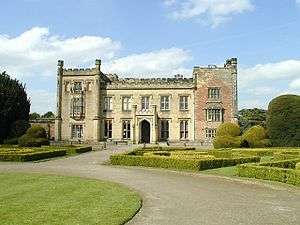Earl of Harrington
| Earldom of Harrington | |
|---|---|
|
Quarterly: Ermine and gule, in the centre a crescent on a crescent for cadency [1] | |
| Creation date | 9 February 1742 |
| Monarch | George II |
| Peerage | Peerage of Great Britain |
| First holder | William Stanhope, 1st Baron Harrington |
| Present holder | Charles Stanhope, 12th Earl of Harrington |
| Heir apparent | William Stanhope, Viscount Petersham |
| Remainder to | Heirs male of the first Earl's body lawfully begotten |
| Subsidiary titles |
Viscount Petersham Baron Harrington |
| Former seat(s) |
Elvaston Castle Harrington House Gawsworth Hall[1] |
| Armorial motto | A Deo et rege ("From God and the King")[1] |
%2C_Attributed_to_Godfrey_Kneller.jpg)
1st Earl of Harrington.


Earl of Harrington is a title in the Peerage of Great Britain that was created in 1742.
Origins
It was created in 1742 for the former Secretary of State and then Lord President of the Council, William Stanhope, 1st Baron Harrington. He had already been created Baron Harrington, of Harrington in the County of Northampton, in 1730, and was made Viscount Petersham at the same time he was given the earldom.[1]
These titles were also in the Peerage of Great Britain. Stanhope was the son of John Stanhope of Elvaston and the great-grandson of Sir John Stanhope of Elvaston, younger half-brother of Philip Stanhope, 1st Earl of Chesterfield (who was the grandfather of James Stanhope, 1st Earl Stanhope).[1]
Lord Harrington was succeeded by his son, the second Earl. He was a General in the Army and also represented Bury St Edmunds in the House of Commons. His son, the third Earl, was also a General in the Army and sat as Member of Parliament for Thetford and Westminster. His elder son, the fourth Earl, and younger son, the fifth Earl, were both Colonels in the Army. The line of the fifth Earl failed on the early death of his son, the sixth Earl, in 1866. The late Earl was succeeded by his first cousin, the seventh Earl. He was the son of the Very Reverend the Hon. FitzRoy Henry Richard, fourth son of the third Earl.[1]
His elder son, the eighth Earl, was a successful polo player. He was succeeded by his younger brother, the ninth Earl. his grandson, the eleventh Earl, succeeded his father in 1929. In 1967, the 11th Earl also succeeded as eighth Viscount Stanhope of Mahon and eighth Baron Stanhope of Elvaston on the death of his distant relative James Stanhope, 7th Earl Stanhope, by a special remainder in the latter's patent that allowed these titles to be inherited by the male heirs of the aforementioned John Stanhope, father of the first Earl of Harrington. As of 2016, the titles are held by the eleventh Earl's son, the twelfth Earl, who succeeded his father in 2009.
The family seat now is The Glen, near Ballingarry, Limerick. The former family seat was Elvaston Castle, in Derbyshire. The house and Grounds are currently owned by Derbyshire County Council, which has opened the gardens as a country park. The 5th Earl had a London townhouse built on land formerly belonging to Kensington Palace: Harrington House remained in the family until the First World War. It is currently home to the Russian Embassy.
Serena Armstrong-Jones, Countess of Snowdon, wife of the Earl of Snowdon, nephew of Queen Elizabeth II, and member of the extended British Royal Family, is the daughter of the 12th Earl of Harrington.
Earls of Harrington (1742)
- William Stanhope, 1st Earl of Harrington (1683–1756)
- William Stanhope, 2nd Earl of Harrington (1719–1779) (son of the 1st Earl)
- Charles Stanhope, 3rd Earl of Harrington (1753–1829) (son of the 2nd Earl)
- Charles Stanhope, 4th Earl of Harrington (1780–1851) (son of the 3rd Earl)
- Charles Stanhope, Viscount Petersham (1831–1836)
- Leicester Stanhope, 5th Earl of Harrington (1784–1862) (brother of the 4th Earl; son of the 3rd Earl)
- Algernon Russell Gayleard Stanhope (1838–1847)
- Sydney Seymour Hyde Stanhope, 6th Earl of Harrington (1845–1866) (son of the 5th Earl)
- Charles Wyndham Stanhope, 7th Earl of Harrington (1809–1881) (1st cousin of the 6th Earl; grandson of the 3rd Earl)
- Charles Augustus Stanhope, 8th Earl of Harrington (1844–1917) (son of the 7th Earl)
- Dudley Henry Eden Stanhope, 9th Earl of Harrington (1859–1928) (brother of the 8th Earl; son of the 7th Earl)
- Charles Joseph Leicester Stanhope, 10th Earl of Harrington (1887–1929) (son of the 9th Earl)
- Charles Stanhope (1921–1921)
- William Henry Leicester Stanhope, 11th Earl of Harrington (1922–2009) (son of the 10th Earl)
- Charles Henry Leicester Stanhope, 12th Earl of Harrington (b. 1945) (son of the 11th Earl)
The heir apparent is the present holder's son William Henry Leicester Stanhope, Viscount Petersham (b. 1967).
The heir apparent's heir apparent is his son the Hon. Augustus Stanhope (b. 2005).
See also
References
External links
- Hansard 1803–2005: contributions in Parliament by Seymour Sydney Hyde Stanhope, 6th Earl of Harrington
- Hansard 1803–2005: contributions in Parliament by Charles Wyndham Stanhope, 7th Earl of Harrington

